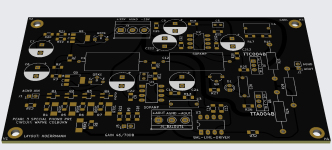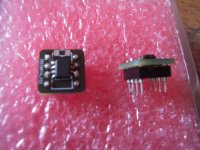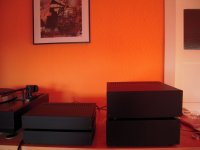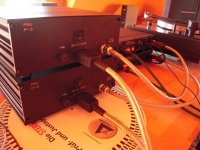I decided up front to solder in the opamp to avoid problems with bad socket connections.
Those sockets (even the best e.g. like Amphenol branded) only "bite" really god the first time you insert an opamp.
You can feel that after some exchanges of opamps the opamp just slides into the socket without much resistance. That is a bad sign and I hate those sockets 🙂 .....I don't think they are approved by NASA.......if so they must be exchanged for each opamp exchange 🙂
Those sockets (even the best e.g. like Amphenol branded) only "bite" really god the first time you insert an opamp.
You can feel that after some exchanges of opamps the opamp just slides into the socket without much resistance. That is a bad sign and I hate those sockets 🙂 .....I don't think they are approved by NASA.......if so they must be exchanged for each opamp exchange 🙂
Only if the green bags cost 10X more.😉I wonder if the kits in the green bags sound better?
I'm not shaking them, I packed every single one.
Thank you for the testing TonyEE.
Guessing the LME49720 noise is the culprit, if there is hiss or a wave rushing sound. I bought 10 or so and a couple had that issue (different phono circuit). One had sensitivity to cell phone noise like there was a junction inside working as a diode detector. Tested them all in a live circuit and tossed the offenders.
You're welcome.
This preamp seems to be built around the opamp...
I'm not shaking them, I packed every single one.
The distance between Mon Chateaux and Masia de Jaume is about 1400 miles. N15 to W40 to N25. I can be there tomorrow morning. Save the green one. Let's plan on eggs benedict to go with it.
LME49720/LM4562 have a known burst-noise issue with some small percentage of devices, and Ti suggests the customers sorting if their application operates in the range of the noise (which is audio, sadly) and low noise is required… because of this I did not choose to use them as the provided opamp in the kit. Which is a shame, as when they are good, they are really, really good.
https://e2e.ti.com/support/audio-gr...um/415907/lm4562-lme49720-low-frequency-noise
https://e2e.ti.com/support/audio-gr...um/415907/lm4562-lme49720-low-frequency-noise
Well, I'm a scientist, not an engineer.... so my sources are more adventurous and I like them that way.
I guess I'll try to get a bunch and see if I can find a set that is not noisy. For sure, I know my "laboratory apparatus" can easily detect the anomalies.
It is, after all, a DIY forum. It I wanted it easy, I'd have a Bose system and an Apple iPhone.
I guess I'll try to get a bunch and see if I can find a set that is not noisy. For sure, I know my "laboratory apparatus" can easily detect the anomalies.
It is, after all, a DIY forum. It I wanted it easy, I'd have a Bose system and an Apple iPhone.
The LME49720 is a very quiet opamp, but somewhat susceptible to RFI. When I get my new power supply in I will compare the noise spectra vis a vis the low noise JFET dual opamp like the LT1113. Let's not render judgment until we have measurement!
I am ears-open for reports on pops, whistles and clicks on turn-on and turn-off.
I am ears-open for reports on pops, whistles and clicks on turn-on and turn-off.
Good morning PEARL 3 - builders,
I had no problems with the LME 49720. They do an excellent job in one of my P3 - versions.
@MEPER: I fully agree, that OPAmp sockets can be a pain. Whether you use the CNC-machined ones or those
with those kind of feather clips...
I have made a few OPAmps in SOIC8 soldered to DIP8 adapters and the adapter-pcb soldered to a DIP8-IC-socket.
Then I push the 'opamp on the DIP8 socket into the ic-socket on the pcb. A lot of effort - but works for me.
But you should always look for good contact
And I go to my next round with this beautiful circuit - single OPAmps. Made some new pcbs for single OPAmps
only. Hope it will work as expected... 🤔
Have a nice weekend and enjoy the beautiful sound!
Cheers
Dirk 😉
I had no problems with the LME 49720. They do an excellent job in one of my P3 - versions.
@MEPER: I fully agree, that OPAmp sockets can be a pain. Whether you use the CNC-machined ones or those
with those kind of feather clips...
I have made a few OPAmps in SOIC8 soldered to DIP8 adapters and the adapter-pcb soldered to a DIP8-IC-socket.
Then I push the 'opamp on the DIP8 socket into the ic-socket on the pcb. A lot of effort - but works for me.
But you should always look for good contact
And I go to my next round with this beautiful circuit - single OPAmps. Made some new pcbs for single OPAmps
only. Hope it will work as expected... 🤔
Have a nice weekend and enjoy the beautiful sound!
Cheers
Dirk 😉
Attachments
And I finished my dual-mono-PSUs for the PEARL 3.
Only waiting for some material for extra - shielding inside the PSU...
Although the PSUs are directly byside of the phonopres - no audible noise.
Cheers
Dirk
Only waiting for some material for extra - shielding inside the PSU...
Although the PSUs are directly byside of the phonopres - no audible noise.
Cheers
Dirk
Attachments
Regarding use of Burson opamps for a phono stage they recommend the V5i only and V6 only for MM.

Snip taken from this site:
https://www.bursonaudio.com/products/supreme-sound-opamp-v6/
Snip taken from this site:
https://www.bursonaudio.com/products/supreme-sound-opamp-v6/
Something new to play with.

OPA1656 and dual OPA627. I want to try OPA1612 in one channel and OPA1656 in the other and then see if I can detect a difference in hiss with my ear to the speaker (voltage noise vs current noise). Also want to try if the OPA627's are still as good as many say they are. These are from Audiophonics made with refurbished parts.
OPA1656 and dual OPA627. I want to try OPA1612 in one channel and OPA1656 in the other and then see if I can detect a difference in hiss with my ear to the speaker (voltage noise vs current noise). Also want to try if the OPA627's are still as good as many say they are. These are from Audiophonics made with refurbished parts.
Just my 2 cents on op-amp sockets, I like using them. And yes my experience in the real world every connector will eventually give a problem one day and certainly hard soldering is best but a socket does allow you to play with different op-amps much easier and this is after all diy. If and when the socket gives a problem just replace the socket just as you would have to do with hard soldered ones if one wants to roll different ones. Makes changing much easier. Of course if you are one to put what you consider the best for you into the circuit with no intention of ever replacing it solder it in.
- Home
- Amplifiers
- Pass Labs
- Pearl 3 Burning Amp 2023




